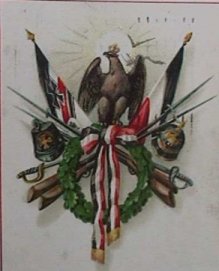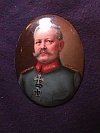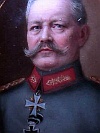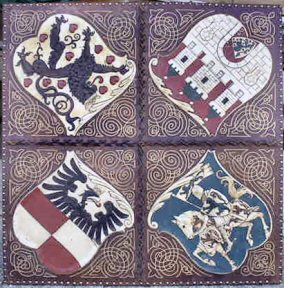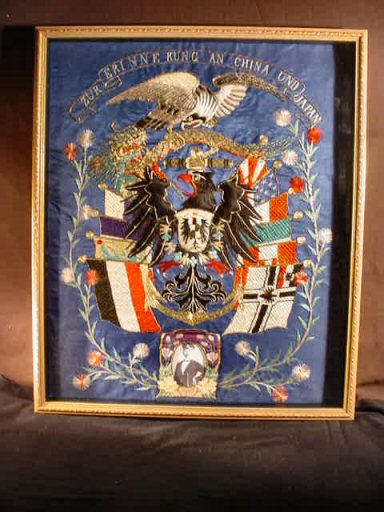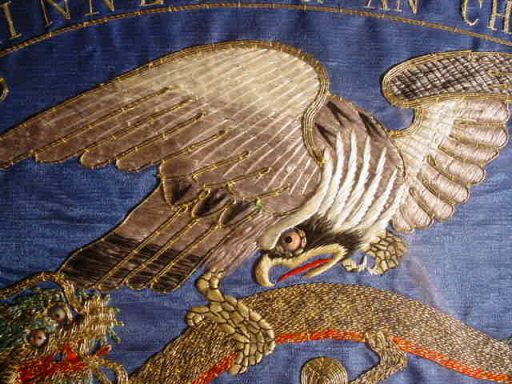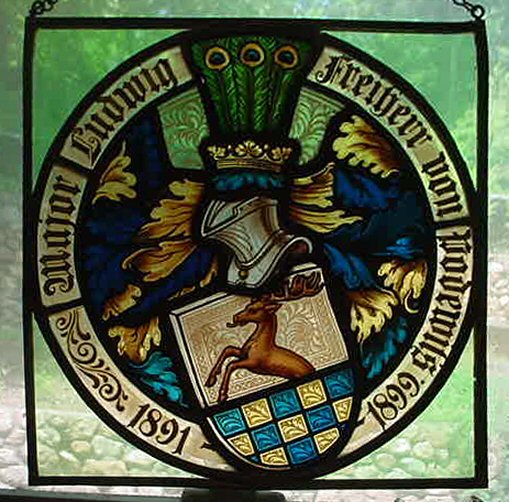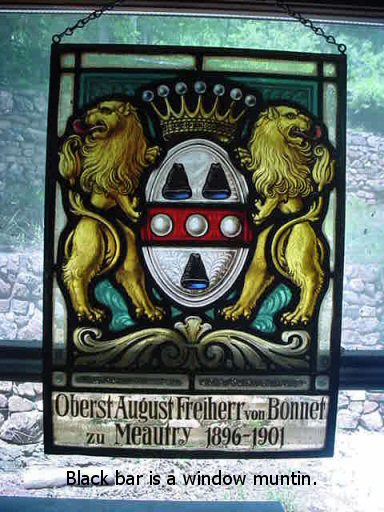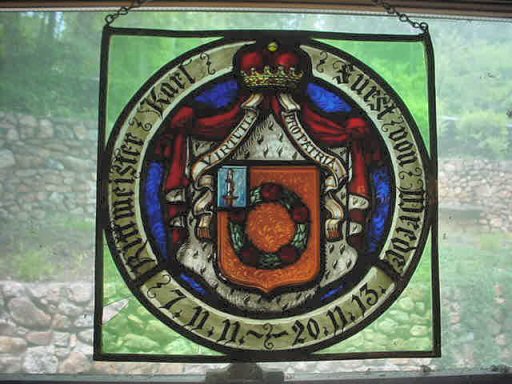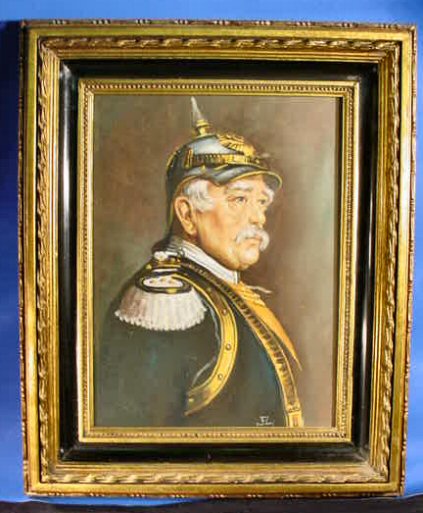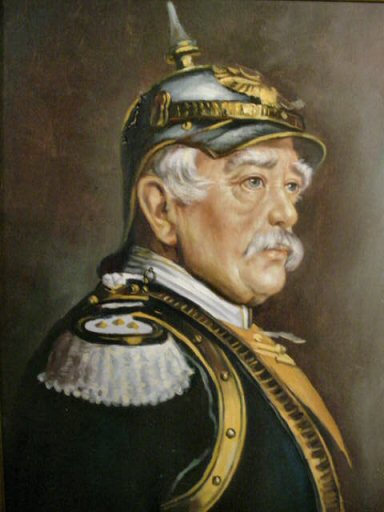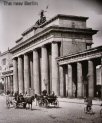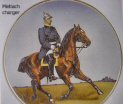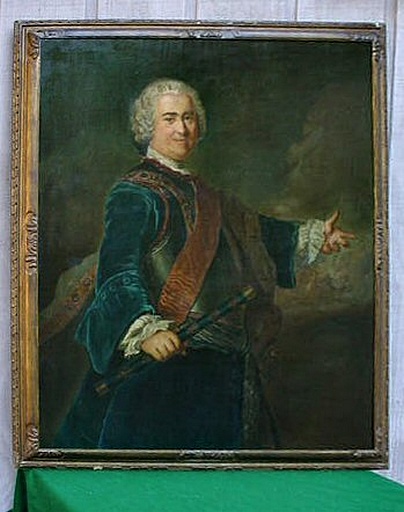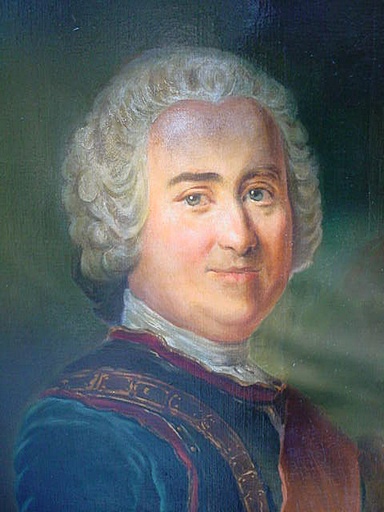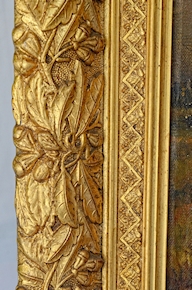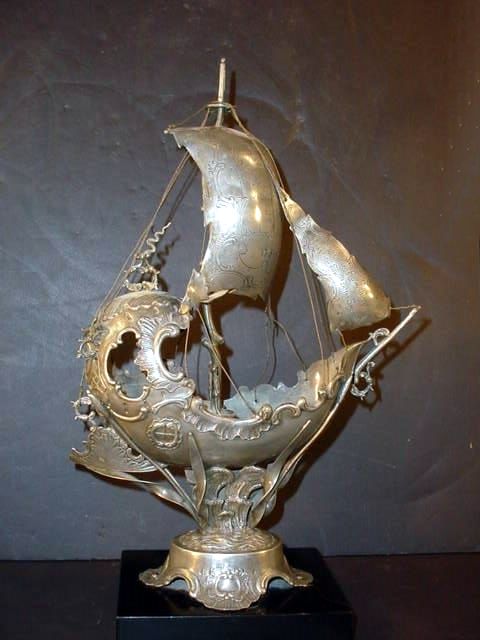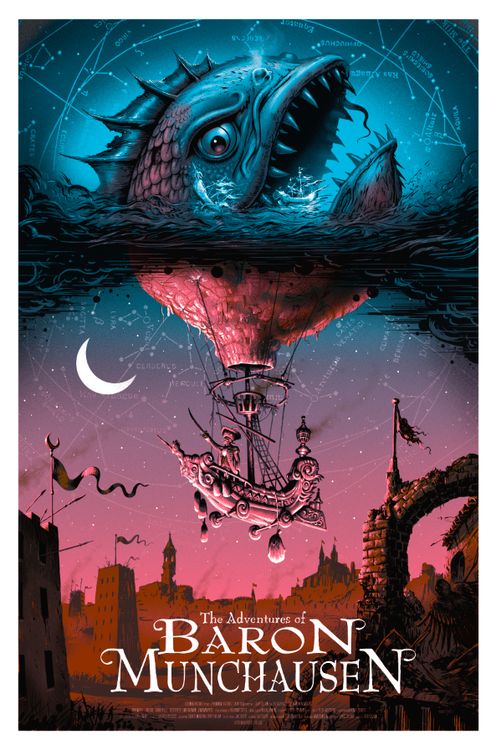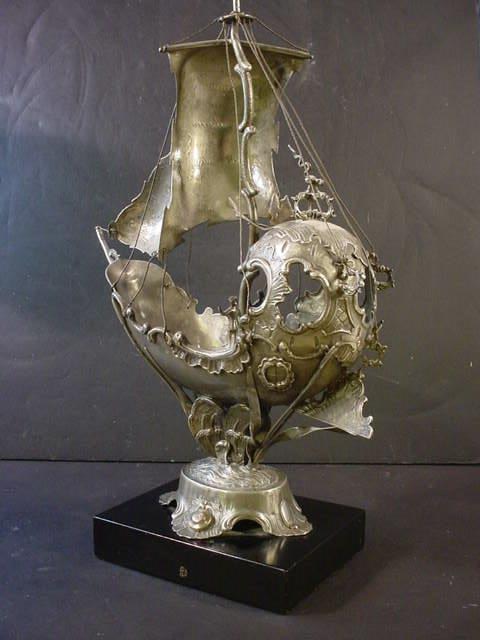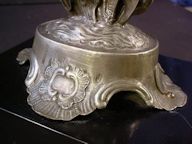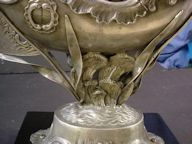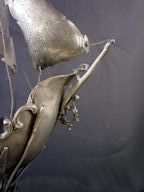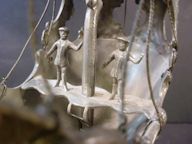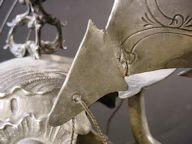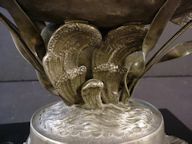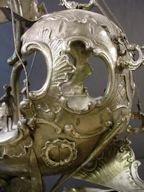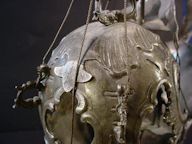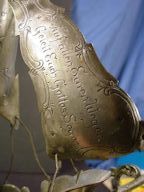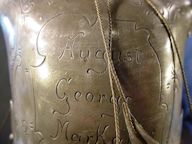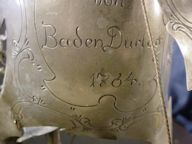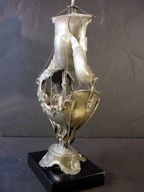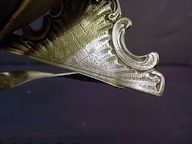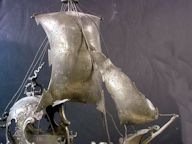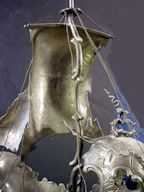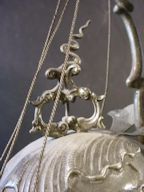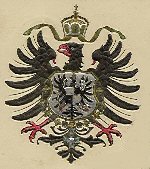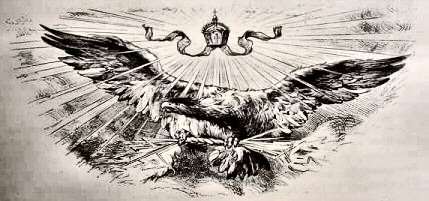|
|
|
|

Paintings
|
|
Please be sure to visit our Kaiser Wilhelm II collection.
Also, take a look at our Frederick the Great gallery.
|
|||||||||
|
HINDENBURG PORTRAIT (Item KPAINTING 1-1) |
|||||||||
| DESCRIPTION: Paul von Hindenburg,
1874-1934, German soldier and statesman born to the old Prussian nobility.
As commander in Chief of the German Army he and General Ludendorf crushed
the Russian Armies at the battle of Tannenburg August 24-31, 1914. This
victory enshrined Hindenburg in the hearts of the German people. On April
26, 1925 at the age of 78 he was elected president of the German Republic,
preceding Hitler. The painting is on porcelain and is wonderfully
executed in minute detail and rich colors. The famous Bavarian firm of
Rosenthal produced it. Evidently the portrait was presented to someone
during the Third Reich period in the same military unit due to the unit,
3/369 written in red on the back. The back of the porcelain also bears the
Rosenthal markings both imprinted and the company paper stamps also
affixed to it. The original frame is 15" x 17" and is about
2" deep. The portrait measures about 9 ¾" x 12". This is a
piece of historical value and is a real museum piece. PRICE: $2250.00 |
|
|||||||
|
Painting in Oil of German Soldier (Item KPAINTING 1-2) |
|||||||
| DESCRIPTION: This original oil of a typical German "Lanser" of WWI is fine in its simplicity. Like millions of other Soldaten he fought for his fatherland and possible his only distinction was that he was immortalized in this fine artist's rendition by C. Schweidler, who painted him during the Battle by Little France in 1916. There is slight crazing and we have shown this in the close-ups. Other than this it is in very good shape. It is mounted in the original frame and measures 21 ½ x 24 ½ inches. The frame is nearly 3 inches thick. This is a fine handmade frame that is an incredible 2 inches deep. It is often said that to realize the realism of a portrait you need to stand back some distance from it. This one can be viewed from any angle or distance and still the face is absolutely lifelike. This was indeed a very accomplished artist. This is a real historical find.
PRICE: $1,200 |
|
|
||||||
|
MINIATURE PAINTING OF A PRUSSIAN OFFICER (Item KPAINTING 1-3) |
||||||
| DESCRIPTION: This is the most incredibly well-done painting that we have ever seen. The color and extreme detail are phenomenal. There is nothing finer-anywhere! Anyplace! To imagine the human being that would be able to create this masterpiece! and in miniature! is to stand in amazement personified! The portrait is of Hern Blumensaat, the king's high official in the military Kabinett and we believe it was painted in 1915 because it came along with a wonderful state portrait in the frame of the Order of the Black Eagle that was presented to him directly from Kaiser Wilhelm, himself. We also have the letter dated June 3, 1915 from the great headquarters where Blumensaat is being informed that he will receive the framed and signed photo of Wilhelm. This miniature portrait was evidently purchased from the family estate. The portrait measures about 2 X 3 inches. It is painted on either ivory or porcelain. We do not wish to disturb it, so it has not been taken apart. It is in its original leather case that is lined with a solid-type material stamped beautifully with the company name of the box maker-Koch-Frankfurt A/M. This is an absolute wonderful portrait of a figure important in history and essentially a masterpiece in its own right.
PRICE: $1,500.00 TRADED; NO LONGER AVAILABLE |
|
|
||||
|
Miniature Portrait of von Hindenburg (Item KPAINTING 1-4) |
||||
| DESCRIPTION: This is the finest portrait study of the Field Marshal we have ever seen in many years of collecting and merchandising Germanic art. It is an actual painting done in the finest form of the art of the miniaturist. It is painted on porcelain and is so lifelike as to be breathing! It measures 2 3/4 x 3 3/4 inches in brilliant colors and deep perception. This work is signed Retrük and whoever that artist was, he could be considered one of the greats.
PRICE: $475.00. SOLD |
|
|
||||||
|
Panzershiff Picture (Item KPAINTING 1-5; KRIEG 4-4) |
||||||
| DESCRIPTION: This is a great picture of the armored fleet leaving Kiel's harbor. Very dramatic and from the collection of a man who collected only WWI naval items. He paid a pretty penny to have it specially framed with the maritime rope framing because he thought so much of it. It truly is a colorful and strong rendition from the brush of Wichmann an artist-of-note during the WWI period. This is a large print measuring 35 x 26 inches in the frame. It would make a great centerpiece for any Imperial Kaiserzeit collection be it general or especially for an Imperial dagger or sword collection. Exquisite!
PRICE: SOLD |
|
|
||||||
|
1870 Franco-Prussian Portrait; Germanophiles, look at this one. (Item KPAINTING 1-6) |
||||||
| DESCRIPTION: This is a period print (huge) measuring 26 x 19 inches overall. The very heavy gilted frame’s measurement is 35 x 28. This is a wonderful artist’s perception of German troops who are stationed or quartered in a French nobleman’s house. It no doubt was by invitation. It is a very busy piece of artwork. We have an infantryman playing the grand piano, while the muddy-booted Kurrisier is undoubtedly singing Die Wacht am Rheine. His comrade sits behind him smoking his long, ceramic bowl pipe. An officer of Dragoons sits sprawled out in a stuffed chair while attentively listening. An enlisted rank stokes the fire in the hearth. A young Hussar in resplendent uniform stands enchanted while he also draws on a regimental-type pipe. In the background the lady of the house or perhaps a maid looks on delightedly with a young lad at her side who is enthralled by the scene. An older Uhlan seems to be getting ready to venture out into the cold once again, while another soldier adjusts a lamp globe that has come loose during all the celebration. The room is replete with 19th-century antiques and exquisite furnishing. This has to be one of the finest large prints we have ever seen that depicts the toughness, but also, the cultural awareness of the Deutsche Soldat in Krieg! The print is in perfect shape and is not faded at all. The colors are still very vibrant. Because of the glass we were not able to perfect our photography on this one, but you probably know we do not exaggerate when we describe so please take our word for it that this is as nice as they come.
PRICE: $450.00 plus s/h/i |
|
|
||||||||
|
Hand-painted Miniature Portrait of Richard Wagner (Item KPAINTING 1-7; ART 6-1; OLD 4-3) |
||||||||
| DESCRIPTION: The great composer, Richard Wagner, regarded himself the most German of men. He wrote 13 world-famous operas and numerous other compositions. He, indeed, was the embodied spirit of German Teutonic dignity and iron resolve. His masterful work stands as evidence of true German culture and history. Besides his activity as a composer and librettist, Wagner wrote an astounding number of books and articles. In fact, he produced about 230 titles. In addition, he wrote about 10,000 letters. Richard Wagner is undoubtedly one of the leading figures of the 19th century. In his time he was a source of heated debate and controversy. When the master died in 1883, over 10,00 books had been written about him and of course the amount of research has multiplied after his death. He was considered along with many other famous people an anti-Semite and radical, even anarchist, and proto-Fascist. In fact, his name appeared in connection to almost all major trends in German history of the 19th and 20th centuries. One of his most poignant sayings seems to sum up his wonderful life and deeds: "I have long been convinced that my artistic ideal stands or falls with Germany. Only the Germany that we love and desire can help us achieve that ideal. This composer in my Germanophile stands head and shoulders above all the other of his great peers. This wonderful rendering of the Meister is one of the best portrayals we have ever seen. It captures all the dignity and charm of this brilliant genius. It is painted painstakingly in miniature by the hand of an extraordinary artist. Each hair of the head is depicted with the tiny brush. The color is still vibrant. It is encased under glass that is beveled with floral design and then instead of the more usual bone piano-key-cut pieces, this one is remarkable and I would say very unusual in that it has an inlaid brass leaf or floral design that was hand cut and inserted masterfully into what appears to be genuine tortoise shell that, in turn, is mounted on bone slabs that make into a planchet. The frame measures 3 ½ x 3 ¾ inches with the oval-shaped painting being about 1 ¼ x 2 inches. The velvet back shows its age (probably as far back as 1870). Underneath the velvet was a covering using a page of newsprint and then you can see the metal tabs holding the portrait in place. Invariably, these are left open from curious individuals probing to check whether the rendering is done on ivory-it is not; it's on porcelain! So Germania now offers the priceless, once again, with a price. Here is a museum piece extraordinaire with an extremely reasonable set worth.
PRICE: SOLD |
|
|||||
|
Royal Imperial Leather Wall Hanging (Item KPAINTING 1-8; ART 6-6) |
|||||
| DESCRIPTION: This is incredible in the extreme. A large section of leatherwork undoubtedly from a royal or governmental office or palace, possibly in the northern Hanseatic areas. At this point we will venture to say INCREDIBLE! This is hand-tooled leatherwork as only the most skilled craftsmen could ever accomplish. It is indeed the Germanophile’s dream. Whether a collector of Imperial relics or the art of the Third Reich period, this has to be the item that would make the heart skip a beat. This is “Deutschland, Deutschland Über Alles” personified! This piece is the ultimate or what make the Teutonic collector do the wild Germanic dance of ecstasy. It is a huge potpourri of panels all joined with leather thong and surrounded with tacks. The panels each depict the coats of arms of various German municipalities. Three of them seem to be the Hamburg area, the Saxon, and the Lioin of Thuringia. I believe this artistic rendition was crafted by Hulbe of Hamburg well know for his fantastic leatherwork. The magnificent leather-carved eagle of the German Empire created on the upright portion of the Reichstag chairs are in a much similar vein. The almost embossed shields stand out as if applied and this makes for an astounding awareness when one considers that they are in fact also hand carved and sculpted in a process known only to Herr Hulbe. The entire item is huge, 40 x 40 inches, with each panel measuring 20 ½ x 20 ½ inches. Of particular note is the depiction of the knight on horseback, who carries an Imperial standard. Rampant lions decorate his shield, horse blankets, and standard. The magnificence of this carved and raised leather art is absolutely profound. The purpose of this great artistic contribution probably was similar to that of a tapestry to hang on a wall of a great room in superb decorative manner possibly behind the chair of a king, prince, or other royalty. This is, if not the must important thing we have ever offered, it could well be the most Teutonically beautiful, as well as extremely historically important.
PRICE: SOLD |
|
||
|
Framed Soldier Print (Item KPAINTING 1-9) |
||
| DESCRIPTION: This is a beautiful print of a bugler of the Pomeranian Fusilier Regiment, No. 34. It is one of the great pictures from the book, Germany’s Army and Navy, published by the Werner Co. of Akron, Ohio in 1889. Beautifully framed in a very expensive frame and very finely matted; super excellent job. It measures 15 ½ x 19 ½ inches in the frame. The print itself is 11 x 15 inches. This is dramatic and colorful.
PRICE: $138.00 |
|
||
|
Grenadier of the Kaiser Alexander Guard Regiment (Item KPAINTING 1-10) |
||
| DESCRIPTION: This unit was named after Tsar Alexander of Russia It is one of the great pictures from the book, Germany’s Army and Navy, published by the Werner Co. of Akron, Ohio in 1889. Beautifully framed in a very expensive frame and very finely matted; super excellent job. It measures 15 ½ x 19 ½ inches in the frame. The print itself is 11 x 15 inches. This is dramatic and colorful.
PRICE: $138.00 |
|
|||||||||
|
Imperial German Framed Souvenir of Trip to China (Item KPAINTING 1-11; KCLOTH 1-14) |
|||||||||
| DESCRIPTION: This is one of the great memory pictures all embroidered by hand in the eastern territories that German ships sailed to in the late 1800s. The workmanship in this item is phenomenal. They did come in varying degrees of artistic excellence and here we offer one of the best of them. They could be ordered during those times from Shanghai to Macao when these hardies were on shore leave. Although oriental, they were expensive in their time and often crew members would pool their money to purchase one to present to a favored captain or officer. The picture is really exceptional in workmanship. Note the workmanship in the faces of the creatures at the bottom. You will see a space left for the picture of the owner. We did not receive this picture from the German dealer, so we used a picture out of a book, but it is commensurate with the period of the whole item. Across the top are words to translate to: “In memory of China and Japan.” The Hohenzollern eagle is seen in the chest shield of the large Reich eagle while an oriental-type eagle and dragon do a bit of combat. The floral designs and ships’ national flags are done to artistic perfection. It has been framed recently as the old frame was nearly falling apart. It measures 28 x 23 inches and is in a very expensive, top-of-the-line framing with recessed depth so that the precious fabric and bullion does not touch the glass. This is not only an important historical relic, but will add 19th-century glory to your den’s wall.
PRICE: $880.00 |
|
||||||
|
Germania Picture (early print) (Item KPAINTING 1-12) |
||||||
| DESCRIPTION: Here is a beautiful rendering of the world’s most beautiful Aryan woman (our bias). The word comes from the ancient name given in the Roman era for a geographic area that stretched from the west bank of the Rhine to a vaguely defined eastern frontier with the forest and steppe regions of modern Russia and Ukraine inhabited by different Germanic tribes. The Germanic people spoke proto-Germanic dialects. For centuries the symbolism for the German lands was depicted in the female warrior with long, flowing blond hair, blue eyes, beautiful shape, and usually brandishing a sword. In the Rhine region, the 132-foot-high monument in Germany’s Niederwald above Rüdesheim is one of the most impressive art statues in Europe. The classic mystical female figure has in her extended right hand the German emperor’s crown and the imperial sword is in her left hand. The monument symbolizes the reestablishment of the German Kaiser Reich, which was a direct result of Prussia’s glorious victory in the Franco-Prussian War, 1870-1871. This led to the unification of Germany under Prussia as its head state as an imperial monarchy. For many years the monument reflected national pride and the much-belated creation of a single German nation today with the context of the new, Americanized Germany with its Coca-Cola culture. Such proud patriotic feelings are just about passé, but as long as even one Germanophile walks and breaths, Fraulein Germania will be one of the most important relics of a far nobler past. The picture is framed in a very special framing with beautiful oak leaf and acorns as the golden motif. This is the surround that Fraulein Germania would have insisted upon; we are sure of that. She bears some of the dings and scratches of time. We believe she was printed in the early 1900s. The colors and the overall appearance is both dramatic and gorgeous. Here in all her glory is Germania, symbol of Germany’s proud past; from Hermann’s victory, to the march in review of the legions of the Wehrmacht.
PRICE: $750.00 |
|
||||||
|
Germania Honor Diploma, Ehren Diplom (Item KPAINTING 1-13) |
||||||
| DESCRIPTION: This is an honorary certificate, or diploma, issued to a Herr Anton Tritschler, to recognize his 40 years of loyal membership and service to the veterans’ organization and to the German fatherland. This is from the veterans’ organization named Konstanz. It was presented to Tritschler in September 1935, during the time of the Third Reich. The beautiful depiction of Germania is very impressive as she holds aloft the wreathed symbol of this organization. In the right corner is an impressive potpourri of headgear, flags, and weapons. This is really a great presentation of one of Germany’s finest. It’s signed by leaders of the group. This is an extremely fine item of great historical importance.
PRICE: $375.00 |
| ||||
|
Fensterglasbilder (Item KPAINTING 1-14; KWINDOW 1-1; KGLASS 2-11) |
||||
| DESCRIPTION: Here is my particular favorite. I love the graphics and the hand painting is superb. This one is done in the square framing with the central theme in circular motif. The almost iridescent blue leaves surrounding the theme just speak of later 19th-century elegance and decorum. The wonderful peacock feathers that emerge from the crowned jousting helmet are artistically superb. The rampant elk is shown on a field of floral design on the glass background. The name who commanded the veteran’s post from 1891 to 1899 was Major Ludwig Freiherr von Podewils. The term “Freiherr” is a word that translates to “baron.” That is a term of royal lineage.
PRICE: $1,850.00: a bargain, indeed! |
| ||||
|
Fensterglasbilder (Item KPAINTING 1-15; KWINDOW 1-2; KGLASS 2-12) |
||||
| DESCRIPTION: Here is one of the most impressive of the Fensterglas grouping in that it has most grand rampant lions which support a central motif that contains WHAT? three cap-looking affairs and three spheres? The central shield is surmounted by a coronet-style crown. This is also the largest of the group—13 1/2 x 10 inches. The reverse painting is spectacular and the golden lions definitely steal the show! The intricate floral fineness intertwined with the hat-looking figures should not be overlooked. The name of this past commander of the group is in the bottommost panel—Oberst August Freiherr von Bonnet zu Meautry, 1896-1901. The military term “Oberst” stands for “colonel” and “Freiherr” added to his name means that the gentleman was a baron, a term of royal lineage. This one, although more simple than some of the others, stand out even more because of the “big cats.”
PRICE: $1,880.00; this should be much more! |
| ||||
|
Fensterglasbilder (Item KPAINTING 1-16; KWINDOW 1-3; KGLASS 2-13) |
||||
| DESCRIPTION: This is another beautiful example of this lost Teutonic art form; this one the most regal of all the collection; regal in that it is decorated in a motif that is decidedly royal. The crown is a prince’s coronet and flowing from this is a royal robe that drapes down to support the central crest that bears a wreath interspersed with red roses and a victory-wreath-wrapped sword. The robe is decorated with ermine tails and has a banner with the words “VIRTUTI PRO PATRIA,” which in Latin means: “With bravery for the native country.” The past commander of the veteran’s unit is seen going around the central motif. He was Rittmeister Karl Forst von Wrende and he served from 7/11/1911 to 20/11/1913. The term “Rittmeister” refers to a rank of captain of the cavalry. This could be Uhlans, Hussars, Cuirassiers, etc. The term “Furst” means “prince.” So this man was a member of Prussian royalty. This is the most important one of the group. It is the only one that shows any damage; however, there is not damage in the central theme. It’s only the square framing where a couple of glass particles have been chipped away. We repeat, noting is broken or chipped in the central leaded glass. This piece measures 10 x 10 inches square on the outside mounting and is the most elaborate presentation of all and surely the most important of the fantastic grouping.
PRICE: $2,200.00; the best! of all of the collection! |
|
||||||||||||
| Painting of Bismarck (1815-1898) (Item KPAINTING 1-17; ART MASTER 1-4) |
||||||||||||
| DESCRIPTION: This is a beautifully executed oil painting of Prinz Otto Eduard Leopold von Bismarck, the German “Iron Chancellor.” This is a purely wonderful depiction of the great German warrior-statesman; regarded as the greatest diplomat of his era. As Minister of Prussia from 1862-1890, he engineered the unification of Germany. When the German Empire was declared in 1871, he served as its first chancellor. He always had the primary objective of ensuring the supremacy of the Prussian state within central Europe and of the aristocracy within the state, itself. His most significant achievement was the creation of the modern German state with Prussia at its core. The final act, the Franco-Prussian War of 1870-1871, saw Prussia break France’s power on the European continent. He also worked to eliminate the political and cultural strength of the Roman Catholic Church and was indeed partially successful. He was often ennobled at least several times through his career. He was made a count (Graf) in 1865, and Furst (prince) in 1871. On his departure from office in 1890, he was made the nonhereditary Duke of Lavenberg, a great and noble Prussian gentleman and advisor to the kings. The oil painting depicts him with the helmet and cuirass of the regiment of royal Prussian cuirassiers. Although he never fought on the battlefield he was always close to these elite soldiers who were considered heavy cavalry. They adored their prince Otto and he was made honorary general of the unit. Thus, he loved to wear the uniform peculiar to this famous outfit. The painting has a very nice frame—new, but stylized to the period. It measures 18 x 22 inches. The actual oil painting measures 15 x 11 1/2. The painting is exquisite in detail and our artist has captured the chancellor in true, living form. He almost breathes. He seems to be almost ready to say, “Wenn die Deutschen zusammenhalten so schlagen sie den teufel aus der hölle!” “When the Germans act in unison then the devil in hell shivers (or shakes).”
PRICE: $750.00; could not be done in this country for near this price |
|
||||||||
|
Giant Portrait of Marshal of Prussia James Francis Edward Keith (Item KPAINTING 1-18; OLD 6-7; FRED 3-10) |
||||||||
| DESCRIPTION: This is a magnificent oil painting of James Keith, who was one of the Scots who left Scotia to fight and direct the wars of central Europe. The fighting Scots were never content to till the soil or to sit in the counting houses. They were warriors and the absolute greatest soldiers that the world has ever seen. It is only too bad that they ever lifted the Claymore for England (my Scottish opinion!). Over the centuries Scottish men have embarked for Germany knowing that at least in Prussia their specialty (warfare) would be appreciated and the German monarchs would be delighted to avail themselves of these services. Many Johnstons, Armstrongs, Andersons, and the brothers Keith heeded the call of Frederick the Great and the Hohenzollern kings such as the Wilhelm I and II. They were like “jewels in the crown” to the Prussians and the Scots usually settled there and their families still remain fully Germanicised, but proud of their Scottish beginnings and heritage. Sir John Keith was no exception; in, fact he proved the rule. Keith, 1696-1758, was Scottish field marshal of Prussia; brother of George Keith, 10th earl marischal (marshal) of Scotland. He participated in the Jacobite uprising of 1715, and in the abortive invasion of 1719 with is brother. Escaping to the Continent, he first entered the Spanish service and then went to Russia, where he gained honor in both civil and military offices. Later, he went to Prussia and became close friends with Frederick the Great, who made him a field marshal (1747). Keith entered the circle of Europe’s leading intellectuals and rendered great service to Prussia in the early part of the Seven Years War. He was killed in the battle of Hochkirch. The painting is beautifully executed, although unsigned. It’s in its original frame and we guess the canvas was done about 1860 or 1870 and it seems to be the original frame, but such as it is, the frame is not nearly as nice as the painting. So our suggestion is that a new, very fancy frame would enhance this piece very nicely. On the back of the frame there was a sticker that has seen better days. In fact, when we moved the painting the sticker came off, but we have preserved it. The sticker or tag gives an address for Mrs. Charles Oswald Liddell of Blinkbonnie (Estate?) in Pinehurst, New Jersey. Written in hand underneath it says: “Field Marshal Lord James Keith; brother of 10th Earl.” Liddel is a Scottish name and Pinehurst was settled by Scottish settlers. Pinehurst is called the Home of American Golf. Golf equals Scottish national pastime. Blinkbonnie Rockliffe is a tiny coastal villa in Scotland and Blinkbonnie is used by guest houses, golf courses, etc., in North Carolina. We found many Liddells on the web and almost all were in North Carolina, but we didn’t find Mrs. C. Oswald Liddell, yet, but we are sure with a bit more intensive search we will come up with the right branch of the family. Could this painting at some time in its history have hung in a grand estate or possible a golf course recreation building or dining hall? The canvas in its frame measures 55 x 45 inches. On the back of the stretcher is a label that is from the Scottish art dealer who sold it probably directly to Mrs. Liddell back then. The dealer was Doic, Wilson & Wheatley, Fine Art Dealers & Printsellers, Picture Restorers & Framers to His Majesty the King. It was established in 1840 and was located in Edinburgh. So, the canvas from all information provided is Scottish all the way, even though Lord Keith’s fame was mostly earned as a Prussian field marshal of great renown. This is a marvelous find and would grace a Scottish collection or a Germanophile would do well to display this great canvas of the marshal extraordinaire!
PRICE: $7,500.00 |
| |||
|
Oil painting on Canvas from the Franco-Prussian-War Period (Item KPAINTING 1-19, WILHELM 9-15; Special Sales) |
|||
| DESCRIPTION: This is a very charming picture that depicts a Prussian soldier—probably an infantryman—as he is seen tipping his Pickelhaube (helmet) and bows his head in prayer. He stands in the forefront of impending battle and implores his God to care for him and his comrades, and procure victory for his Fatherland. The buckles of the Prussian army and later the entire German army proclaimed Gott mit uns (God with us) and God was certainly with them in this 1870-71 war with France. The combined German forces under the leadership of Prussia and Kaiser Wilhelm I utterly trounced the French forces of Napoleon II there, and because of the solidarity and cooperation of the other Germanic states, which joined Prussia in the fight, the way was paved for the great unity and brought forth for the first time the unified German nation; this was proclaimed at the Versailles Hall of Mirrors in 1871. This soldier personifies the deep religious feeling as experienced by the average German solider. This man is, however, an officer as evidenced by his uniform and helmet fittings. The presentation is certainly charming, compelling, and inspiring. Here is the brave Teutonic warrior speaking to his creator with an appeal on his own behalf and for heavenly protection for his soldier comrades that we can perceive in the background of the scene. The frame is a precious relic on its own and is as German as sauerkraut! It employs deep-relief oak leaves and acorns all around its framing; absolutely beautiful in its overall presentation. Inside the outer frame parameters is a beautiful Victorian-style motif that serves as an inner bezel. The frame measures 28 x 20 inches and is about 3 ½ inches wide including the bezel. The painting measures about 12 by 20 inches and is in really fine condition considering that it is probably over 142 years old. It is 100 percent original to the period, as is the frame. This is a real museum piece and it brings an important truism!: A fact from the past that gives a revisionist perspective that flies in the face of so much dubious propaganda (so-called facts) about the German war machine and the so-called German propensity for cruelty and antireligious leanings. In other words, so much Hogwash! Here is the typical God-fearing “Deutscher Soldat” in direct communication with his lord.
“Gott Mit Uns
PRICE: SOLD |
|
|
|
Please refer to item designator in parentheses in all correspondence.
Please E-mail for any additional information you may need.If you prefer, contact 'Germania' at PO Box 68, Lakemont, GA 30552
or call at 706.782.1668.
Please! do not call during the wee hours of the morning. The best time for calling us is between 9 and 11 am and between 9 and 11 pm eastern time.



